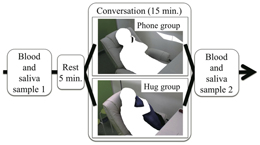Research Abstract
抱き枕型の通信メディアを使うとコルチゾール値が減少する
Huggable communication medium decreases cortisol levels
2013年10月23日 Scientific Reports 3 : 3034 doi: 10.1038/srep03034

人間同士の体の接触は、身体的および心理的な苦痛を和らげる場合があり、それゆえ社会的交流の基本要素の1つとなっている。こうした人間同士の接触に伴って見られる心理的および生理的効果を再現するため、触って気持ちのよい感触を通信機器に実装させることへの関心が高まっている。しかし、そうした機器との身体的接触が、実際の人間同士の接触で見られるような客観的に測定できる内分泌系への効果をもたらすかどうかは、まだ分かっていなかった。我々はこの可能性を直接的に検証するため、抱き枕型の通信機器を用いた会話の前後で、ストレスホルモンであるコルチゾールの分泌量変化を調べた。被験者には、人の形をした抱き枕型の通信機器と携帯電話のどちらかを使って、離れた場所にいる見知らぬ相手と15分間話をしてもらった。この実験で、抱き枕型の通信機器で会話をした被験者ではコルチゾール分泌量が有意に低減することが明らかになった。通信メディアの効果を生物学的マーカーによって評価した今回の取り組みは、現代の高度なネットワーク社会で個人間を結ぶ通信メディアにおいて、社会的交流を支援するシステムを向上させるような新しい設計の方向性を示している。
住岡 英信1, 中江 文2, 金井 良太3,4 & 石黒 浩1,5
- 国際電気通信基礎技術研究所 石黒浩特別研究室
- 大阪大学大学院医学系研究科 麻酔集中治療医学講座
- ロンドン大学ユニバーシティカレッジ 認知神経科学研究所(英国)
- サセックス大学 サックラー意識研究センター(英国)
- 大阪大学大学院基礎工学研究科 システム創成専攻
Interpersonal touch is a fundamental component of social interactions because it can mitigate physical and psychological distress. To reproduce the psychological and physiological effects associated with interpersonal touch, interest is growing in introducing tactile sensations to communication devices. However, it remains unknown whether physical contact with such devices can produce objectively measurable endocrine effects like real interpersonal touching can. We directly tested this possibility by examining changes in stress hormone cortisol before and after a conversation with a huggable communication device. Participants had 15-minute conversations with a remote partner that was carried out either with a huggable human-shaped device or with a mobile phone. Our experiment revealed significant reduction in the cortisol levels for those who had conversations with the huggable device. Our approach to evaluate communication media with biological markers suggests new design directions for interpersonal communication media to improve social support systems in modern highly networked societies.

